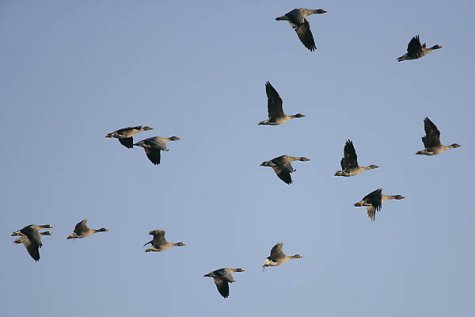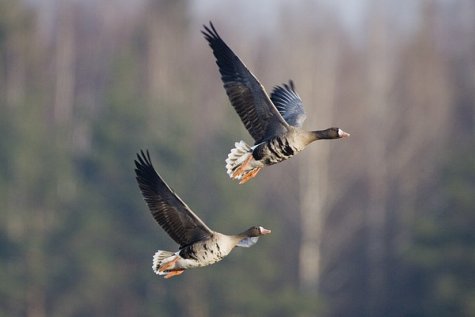Weather change initiated the migration of bean geese
Photos: Arne Ader
Translation: SilverT
Bean geese and white-fronted geese
Bean goose Rabahani Anser fabalis
Passing bean geese can be seen in Estonia almost until the end of November. They do not nest here. Earlier bean geese overview can be seen below for comparison.
In the inland, great places for bean geese observations are the polders of Aardla and Räpina, lakes of Vooremaa and the surroundings of Ilmatsalu fish ponds. In western Estonia, Silma and Matsalu, after that Häädemeeste shore meadows and Audru. It is estimated that 25 000 migratory bean geese stop here, which means the numbers are similar to the leaving greylag geese; these are the birds we can meet most often.
Bean geese look rather dark in the air: the plumage on the head and neck are dark brown and the greyish-brown stomach feathers do not have any spots. In the center of the black beak is a bright orange pattern, which is individual for each bird. Adult birds have orange legs and young birds`legs are slightly more yellow.
Bean geese migration can be observed in the Biodiversity database: LINK
Greater white-fronted geese
Greater white-fronted geese
Suur-laukhani Anser albifrons
As a rule, greater white-fronted geese that are going through their autumn migration do not stop in Estonia, but there are about a couple of hundred thousand birds flying over and on some beautiful autumn day the migration may seem „endless“. As they fly over, their melodic „song“ sounds „kaga-kligi-kaga-kligi...“, being significantly different from the trumpeting and nasal sounds of bean geese.
As a characteristic of the species, the root of the beak has a distinguishable white blaze, which reaches all the way to the forehead. The colour of the beak and legs is of similar orange as for greylag geese. Greater white-fronted geese have well-noticeable crossed stripes on their stomach feathers; young birds will not have them before next autumn. Migrant flocks can be distinguished with a binocular and by hearing.
In the autumn, a birdman with a good observation tube may find a single lesser white-fronted goose from the large flock of geese – a rarity who is among the most endangered bird species in Europe.
Greater white-fronted geese migration can be observed in the Biodiversity database:LINK
So far, no lesser white-fronted geese have been spotted this autumn: LINK










